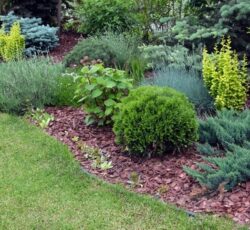 Maintaining a beautiful and well-kept outdoor space can be time-consuming and expensive. However, with the right design and careful planning, you can create a low-maintenance landscape that requires minimal effort and resources to look its best. In this blog post, we will explore some key principles and strategies to help you create a low-maintenance landscape design that is both aesthetically pleasing and easy to manage.
Maintaining a beautiful and well-kept outdoor space can be time-consuming and expensive. However, with the right design and careful planning, you can create a low-maintenance landscape that requires minimal effort and resources to look its best. In this blog post, we will explore some key principles and strategies to help you create a low-maintenance landscape design that is both aesthetically pleasing and easy to manage.
1. Start with a Good Foundation
The foundation of any landscape design is the selection of suitable plants and materials. Choose native or drought-tolerant plants that require less water and upkeep. These plants are more adapted to the local climate and will thrive with minimal care. Similarly, opt for low-maintenance materials, such as gravel, rock, or mulch, instead of high-maintenance grass or exotic plants.
2. Incorporate Hardscapes
Hardscapes are permanent structures and features in a landscape that require negligible maintenance. Consider adding features such as paths, patios, decks, and fences to your outdoor space. These elements not only add structure and functionality to your landscape but also reduce the amount of green space that needs to be maintained.
3. Implement Smart Irrigation Systems
Watering your plants efficiently is crucial for a low-maintenance landscape. Install a smart irrigation system that can be programmed to water your plants at specific times and adjust watering levels based on weather conditions. Drip irrigation, for example, delivers water directly to the roots of plants, promoting efficient water usage and reducing the need for constant watering and manual intervention.
4. Create Functional Planting Beds
Divide your landscape into functional planting beds, each with a specific purpose. Consider a bed for flowers, another for edible plants or a vegetable garden, and one for low-maintenance ground cover. By designating specific areas for different types of plants, you can streamline maintenance tasks such as watering, pruning, and fertilizing, making them more manageable.
5. Use Mulch and Ground Covers
Mulching your planting beds provides numerous benefits in terms of reducing maintenance. Firstly, it helps to conserve moisture in the soil, preventing the need for frequent watering. Secondly, mulch acts as a natural weed suppressor, reducing the need for manual weeding or herbicides. Thirdly, it helps to regulate soil temperature, protecting plants from extreme weather conditions. Similarly, consider using low-maintenance ground covers, such as creeping thyme or stonecrop, to fill in empty spaces and reduce the need for frequent mowing or weeding.
6. Minimize Lawn Area
Lawns are notorious for their high maintenance requirements, including regular mowing, fertilizing, weeding, and watering. Consider reducing the size of your lawn or eliminating it altogether in favor of low-maintenance alternatives. For instance, you could create a small patch of grass for leisure activities and replace the remaining area with native plants, ground covers, or a hardscape feature such as a deck or patio.
7. Opt for Perennials
Choosing perennials over annuals can significantly reduce maintenance efforts in your landscape. Perennials come back year after year, requiring minimal care once established. They have deeper roots, making them more resilient to drought conditions, and they generally have less pest and disease issues. By incorporating a variety of perennial plants in your landscape, you can enjoy a colorful array of flowers and foliage with minimal upkeep.
8. Embrace Natural Processes
Consider incorporating natural processes into your landscape design to reduce maintenance tasks. For example, creating a rain garden can help manage excess water runoff and reduce the need for manual watering. Similarly, incorporating a composting area can help produce nutrient-rich soil amendments for your plants, reducing the need for synthetic fertilizers. By working with nature rather than against it, you can create a sustainable and low-maintenance outdoor space.
Summary
Creating a low-maintenance landscape design requires careful planning, selection of suitable plants, and implementation of smart strategies. By following these principles, you can reduce the time and resources needed to maintain your outdoor space while still enjoying a beautiful and thriving environment. So, go ahead and design your low-maintenance landscape to free up more time for leisure and relaxation.

